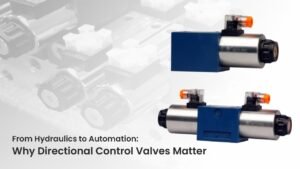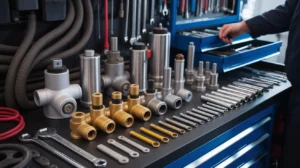Gear pumps form an important component of hydraulic systems and are highly valued due to their constant flow rate, durability and small size. An external gear pump or an internal gear pump is an effective device that converts rotational speed to a steady hydraulic flow. This article will discuss the functionality of gear pumps and their use in hydraulic systems, as well as why they are deemed the best choice when it comes to light-duty and heavy-duty work.
Types of Gear Pumps
- Exterior Gear Pump
Applies two identical gears turning opposite to each other. Typical of industrial gear pumps.
- Internal Gear Pump
Has a gear within another, which can operate more smoothly and silently. Excellent in high quality gear pump applications.
How Gear Pumps Provide Steady Flow
Among the key benefits of hydraulic gear pump usage, there is the possibility to provide a smooth, non-pulsating flow, which is proportional to the rotational speed. Here’s how:
- Positive Displacement Action
The gear turns a certain amount of fluid each time. This is so that the flow rate can be maintained constant despite the fluctuation in the system pressure.
- Gear Teeth Engagement
The gears are in constant motion of trapping and displacing fluid. This design reduces the back flow, which is the key to the high pressure gear pump performance.
- Rotational Speed vs Flow Rate
The rate of flow (Q) of gear pump is directly proportional to the rotational speed (N):
- ini
- Copy
- Edit
- Q = Distance travelled x Velocity
Therefore, doubling the rotational speed doubles the flow and they are predictable and reliable.
Advantages of Gear Pumps
When you want to purchase gear pump online or want to find a gear pump on sale, then these are good reasons why you should buy them:
- Uniform Output Flow
- Compact Lightweight Design
- Low Cost and Low Price Gear Pump Alternative
- Low Maintenance
- Deals With High Pressures Effectively
- Suitable in Viscous Fluids
Applications in Industry, Automotive and Agriculture Are Widespread
Typical uses of Gear Pumps
Hydraulic gear pumps are very versatile. You will find them in:
- Hydraulic presses
- Machines that do injection molding
- Lubrication systems
- Automotive transmissions
- The food processing industries
- Construction machinery
Heavy-duty gear pump or compact external gear pump, both are used in a wide range of industries.
Tips for Choosing the Right Gear Pump
To maximize your investment, the following are some of the important tips:
Know thy application
Select either the internal gear pump to have a smooth flow or an external gear pump to have a high-speed operation.
Prssure Ratings Check
In case of systems that require more pressure, use a high pressure gear pump to provide reliability and safety.
Material Compatibility
Make sure that the pump materials are compatible with the fluid being pumped. Corrosive liquids are favored with stainless steel models.
Talk to an Industrial Gear Pump Supplier
A well known industrial gear pump supplier will offer advice, technical assistance and the most suitable products.
Buying Gear Pumps Online: What to Know
The increasing number of buyers purchase gear pump online because of convenience and wide availability. When searching a gear pump on sale, one should always look at:
- Product specifications
- Return and warranty policy
- Brand reputation and reviews
- Comparisons of the cost of affordable gear pumps
Ensure that the platform has quality products of gear pumps with professional assistance.
Maintenance Tips for Long Gear Pump Life
Keeping your gear pump in good condition will keep your pump flowing well and will prolong its working life:
- Periodic Inspection of Oil
- Check Seals and Bearings
- Do not Run Dry
- Change Worn Gears in a Timely Manner
- Change Clean Filters Regularly
Careful maintenance ensures your industrial gear pump is in good shape even when put under heavy-duty conditions.
Conclusion: Reliable Flow with Every Rotation
Gear pumps are a workhorse in the hydraulic business. The characteristic that makes them the backbone of fluid power systems is their capacity to provide constant flow at variable rotational rates, whether you are dealing with an external gear pump that is used in harsh conditions or an internal gear pump that is used in precision applications.
When you are all set to purchase a gear pump online, then focus:
- Performance
- Reliability
- Application-specific fit
- Professional supplier assistance
Reliable manufacturers such as THM Huade have a variety of gear pumps that are design to be durable and efficient thus your hydraulic systems will be running under the harsh conditions.
Whether you require a heavy-duty gear pump, an affordable gear pump, or you want to know the best hydraulic gear pump available; there is no better time to invest in quality gear pump technology.
FAQs
Q:1 What is the working principle of a gear pump?
Gear pump is based on the principle of positive displacement and the fluid is trapped between the teeth of gears and is moved through the inlet to the outlet by the rotation of the gears.
Q:2 How does speed affect the flow in a gear pump?
The gear rotation speed influences the flow rate directly. Increased speed implies increased flow rate and hence the performance of the pump is easily regulated.
Q:3 Is internal gear pump or external gear pump better?
Each of them is strong in its own way:
External gear pump- most suitable in high pressure, high speed systems.
Internal gear pump – less noisy and is more suited to low-speed, high viscosity fluids.
Q:4 What is the function of the gearbox pump?
A gearbox pump moves hydraulic fluid in and out of systems by means of rotating gears. It produces constant flow and pressure to drive the hydraulic equipment.
Q:5 Can a gear pump work in both directions?
Yes, a large number of gear pumps can be bi-directional. Nevertheless, make sure the pump design has reverse flow capability to prevent damage.



